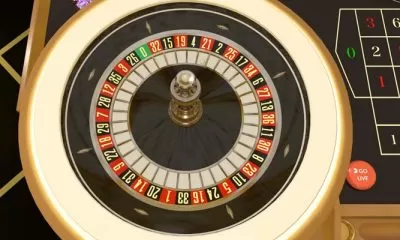Casino
The World of Solitaire Invites You to Learn, Play, and Win!
Published
7 months agoon
By
Sam Jonson
Solitaire is a classic online casino card game that offers simple yet engaging gameplay. Players aim to arrange a deck of cards into ascending order by suit, starting with aces and ending with kings. The game typically involves single-player mode and uses a standard 52-card deck. Players move cards between columns, utilizing strategic thinking to uncover hidden cards and create sequences.
Solitaire game play tests players’ problem-solving skills, patience, and decision-making abilities. Online versions often include various themes, customizable card backs, and scoring systems, providing a relaxing and enjoyable casino-style experience accessible from the comfort of one’s device.
History
One of the prevailing theories about the origins of Solitaire suggests it emerged in France during the 18th century, a notion that appears reasonable given the French influence on various game-related terminology (notably “tableau”). Interestingly, the earliest documented title for the game we now recognize as Classic Solitaire was “Patience,” a term stemming from Old French, specifically “Patiens.”
As time passed, the game’s name evolved and became synonymous with Solitaire, Klondike, Canfield, and similar titles, yet “Patience” appears to be the most ancient appellation. While there’s a charming, albeit unverified, anecdote linking the game’s invention to a French nobleman during the tumultuous French Revolution.
If the notion of a French origin or cartomancy doesn’t pique your interest, you might find the theory of Solitaire’s invention in Germany more appealing. Although the game might have been in existence and enjoyed by many prior to this, the formal description and rules of Patience games were initially documented in an anthology of games written by a German author around 1788, providing the first known account of the game.
Over time, the Solitaire game has found its way into numerous game compendiums, marking its initial appearance in 1870 with the release of “Patience: A Series of Thirty Games with Cards” in the United States.
In 1913, the world was introduced to Klondike Solitaire through the “Official Rules of Card Games.” This particular variant of the game experienced a resurgence in Solitaire’s popularity and ultimately became the most widely played version worldwide. Its popularity soared to such an extent that it was the version chosen as the first digital adaptation of Solitaire. Who doesn’t know about Microsoft Solitaire? Guess nobody!
Goal
The goal of the Solitaire classic casino game is to arrange a standard deck of 52 cards into four foundation piles, sorted by suit and in ascending order from Ace to King. Players move cards between tableau columns, revealing hidden ones to strategize moves. The game demands skill, patience, and careful planning. Successful completion results in all cards stacked in foundation piles, showcasing a player’s mastery of the game’s mechanics.
You can practice playing it for free on sites like Solitaire Bliss or Solitaire apps!
Solitaire rule and terminology
Solitaire, an ace card game often known as Klondike, comes with a specific set of terms to describe its various elements and actions. Familiarizing yourself with these terms is crucial for a better understanding of the game.
Foundation
There are four foundation piles, one for each suit (hearts, diamonds, clubs, and spades). The objective is to build these piles up in ascending order, starting with the Ace and ending with the King, using cards of the same suit.
Tableau
The tableau is the primary playing area where cards are organized into columns. Players can manipulate cards within the tableau to uncover hidden cards, create sequences, and ultimately build the foundation piles.
Stock
The stockpile holds the undealt cards. Players draw cards from the stock to make moves in the tableau or to the waste pile.
Waste pile
Cards drawn from the stock are placed in the waste pile. Players can also move cards from the tableau to the waste pile as part of their strategy.
Columns
These are the vertical stacks of cards in the tableau. Cards within columns must be arranged in descending order and alternately colored. Players move cards between columns to reveal hidden cards and create sequences.
Tableau space
A designated area in the tableau where cards can be placed or moved temporarily during the game.
Draw
The action of taking a card from the stock and adding it to the waste pile or tableau.
Foundation move
When a player successfully moves a card to one of the foundation piles, it is referred to as a foundation move.
Build
The process of arranging cards within the tableau columns in descending order and alternating colors.
Reveal
The act of turning over a facedown card in the tableau, making it available for play.
Home cell
An alternate term for the foundation pile, signifying the final destination for cards.
Stacking
Placing a card on top of another within a tableau column in descending order and with alternating colors.
Auto-move
Specific digital versions of Solitaire offer an auto-move feature that automatically moves cards to the foundation piles when appropriate.
Deal
The initial distribution of cards to the tableau columns and waste pile at the start of the game.
Talon
Another name for the stockpile, especially in some Solitaire variations.
Winning
Achieved when all cards are successfully moved to the foundation piles in ascending order by suit.
Comprehending these Solitaire terms is essential for mastering the game and implementing effective strategies, contributing to an enjoyable and challenging card-playing experience.
How to play?
Arrangement
Solitaire set up involves arranging the cards into the tableau, foundation, stock, and waste pile. Here’s how it is done –
Tableau
Seven piles of cards from a standard 52-card deck are created. The first pile contains one face-up card; the second pile has one facedown card and one face-up card, and so on, with each subsequent pile having an additional facedown card and one face-up card. Arrange the tableau in a cascading style so that the cards are partially overlapped and form a column.
Foundation
There are four foundation piles, initially empty. These will be used to build sequences of cards from Ace to King, one for each suit (hearts, diamonds, clubs, and spades).
Stock
Place the remaining cards facedown to form the stockpile. This pile serves as a source for drawing cards during the game.
Waste pile
Initially, there are no cards in the waste pile. As the game progresses, cards from the stock or tableau can be moved here.
To sum up, the tableau starts with seven piles, the first having one face-up card, the second with one facedown and one face-up card, and so on. The foundation piles are empty, and the remaining cards form the stockpile, and are face down. There is no waste pile at the beginning. Solitaire’s setup encourages strategic moves within the tableau and foundation, making it a challenging and enjoyable card game.
The final objective is to move cards within the tableau and from the stockpile to the foundation piles, following the game’s rules, to win.
Solitaire play
- Move cards within the tableau to create descending sequences in alternating colors. For example, you can place a red 5 on a black 6.
- Reveal facedown cards by freeing them with face-up cards and strategically using empty tableau spaces.
- If you have an Ace, place it in a foundation pile. Subsequent cards of the same suit can then be added in ascending order.
- The waste pile’s top card can be played in the tableau or foundation piles.
- To access the stockpile, draw one card at a time. Place it in the tableau or on the foundation piles if applicable. The stockpile is usually cycled through three times.
Winning
Win by successfully filling all four foundation piles with cards from Ace to King, one for each suit.
If no more moves are possible in the tableau, and the stockpile is exhausted, the game is over, and you may not have won.
Scoring
Scoring in Solitaire casino games can vary depending on the specific rules or variations being used. Winning the game is often the most significant factor in determining your score. However, here is a general overview of scoring in Solitaire –
Time-based scoring
Some versions of Solitaires track the time it takes to complete a game. Players can compete to finish the game in the shortest time possible. The faster you complete a game, the better your score will be. This scoring method encourages players to improve their speed and efficiency.
Move-based scoring
In some variations, your score is affected by the number of moves you make. Fewer moves result in a higher score. This scoring system rewards players who make strategic and efficient moves, as unnecessary moves can reduce their score.
Bonus points
Some Solitaire versions offer bonus points for achieving specific milestones, like successfully moving a King to an empty column or filling a foundation pile. These bonus points can boost your overall score.
Penalties
Conversely, some versions may deduct points for using the undo or hint features or reshuffling the stockpile. These penalties are designed to discourage players from relying too heavily on these aids.
Cumulative scoring
In a series of games, players may earn points based on their performance in each game. Cumulative scoring can be used in competitive Solitaire tournaments, where players accumulate points over multiple rounds.
Variation-specific rules
Scoring can also vary depending on the specific Solitaire variation being played. For instance, in Spider Solitaire, the goal is to create complete sets of suited sequences, and points are often awarded based on the number of completed sets.
It’s essential to check the rules and scoring system of the specific Solitaire card game online before playing, as different variations and digital versions may have their own scoring methods. Scoring can add an element of competition and challenge to Solitaire, encouraging players to improve their skills to aim for higher scores.
Strategies
- Prioritize moving cards to reveal facedown ones.
- Free up columns for King placement.
- Be cautious about using the waste pile too quickly; it may contain crucial cards.
Solitaire combines strategy and patience, offering an engaging and relaxing card game experience. The challenge lies in skillfully manipulating the tableau and making the right moves to build the foundation piles and secure a victory.
Popular Solitaire card game variations
Solitaire has evolved into numerous popular variations, each with its own unique rules and challenges. Some of the most well-known Solitaire variations are listed here.
1.Klondike Solitaire
In the classic Solitaire version, players aim to build foundation piles from Ace to King by arranging tableau columns in descending order and alternating colors.
2.Spider Solitaire
Played with two decks of cards, the goal is to create complete sequences of the same suit from King to Ace. It’s known for its complexity and multiple tableau piles.
3.Freecell
In Freecell, all cards are dealt face-up, and players can move sequences of cards between columns, aiming to arrange them in ascending order within the foundation piles.
4.Pyramid Solitaire
In this version, a pyramid of cards is built, and players must pair cards that add up to 13 to remove them. The goal is to clear the pyramid entirely.
5.TriPeaks
Players remove cards by selecting ones that are one rank higher or lower than the foundation card. The objective is to clear all cards from the tableau.
6.Golf Solitaire
This game focuses on clearing the tableau by selecting cards one rank higher or lower than the foundation card. The goal is to minimize the number of remaining cards.
7.Yukon Solitaire
Similar to Klondike, but with an open tableau, making all cards visible. Players must build foundation piles from Ace to King.
8.Double Solitaire
Besides one player or solo games, there are dual player Solitaire games.
Two-player Solitaire card play is also known as “Russian Bank”, a competitive game typically played with two standard decks of cards. Each player has their own tableau and foundation piles. The objective is to build the foundation piles with a card sequence from Ace, 2, 3, to King.
Players can interfere with each other’s tableau by playing cards in ascending or descending order. The game involves strategic card management, quick thinking, and blocking opponents from making progress.
It’s a fast-paced and engaging version of Solitaire that adds a competitive element, making it ideal for two players looking for a challenging and interactive card game.
These variations offer diverse challenges, making Solitaire a versatile and engaging casino game that appeals to a wide range of players. Each version requires distinct strategies and provides a unique gaming experience! So why wait to start playing and get Solitaired?
You may like
-
High Low Game: How and Why to Play, Variations, and Strategies
-
Decoding Baccarat: A Beginner’s Guide to the Game
-
Live Speed Baccarat: Game Rules, How to Play, and Strategies
-
A Comprehensive Guide to Play Poker Online with Friends
-
How to Play Roulette: Everything You Need to Know about Casino Roulette Game
-
Play Online Roulette Successfully: 6 Proven Strategies to Help You Win












